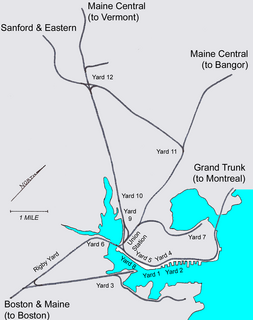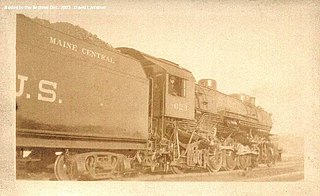
A 4-6-0 steam locomotive, under the Whyte notation for the classification of steam locomotives by wheel arrangement, has four leading wheels on two axles in a leading bogie and six powered and coupled driving wheels on three axles with the absence of trailing wheels.

The St. Lawrence and Atlantic Railroad, known as St-Laurent et Atlantique Quebec in Canada, is a short-line railway operating between Portland, Maine, on the Atlantic Ocean, and Montreal, Quebec, on the St. Lawrence River. It crosses the Canada–US border at Norton, Vermont, and Stanhope, Quebec, and is owned by short-line operator Genesee & Wyoming.

The Indian Railways primarily operates fleet of electric and diesel locomotives, along with several compressed natural gas (CNG) locomotives. Steam locomotives are operated on a few World Heritage Sites and also run occasionally as heritage trains. A locomotive is also known as a loco or more popularly as an engine. The country's first steam locomotive ran on the Red Hill Railway from Red Hills to the Chintadripet bridge in Madras in 1837.

The Portland Terminal Company was a terminal railroad notable for its control of switching (shunting) activity for the Maine Central Railroad (MEC) and Boston & Maine (B&M) railroads in the Maine cities of Portland, South Portland, and Westbrook.

The Mountain Division is a railroad line that was once owned and operated by the Maine Central Railroad (MEC). It stretches from Portland, Maine on the Atlantic Ocean, through the Western Maine Mountains and White Mountains of New Hampshire, ending at St. Johnsbury, Vermont in the Northeast Kingdom. The line was abandoned in 1983 by MEC's successor, Guilford Transportation Industries (GTI). Guilford retained a stub between Portland and Westbrook. A section in New Hampshire remains in use by heritage railway Conway Scenic Railroad.
The Bucksport Branch is a railroad line in Maine that was operated by the Maine Central Railroad. It is now part of the Pan Am Railways system.
The Calais Branch is a mothballed railroad line in Maine that was operated by the Maine Central Railroad Company (MEC).

Maine Eastern Railroad was a railroad that operated in coastal Maine, between Brunswick and Rockland, on the former Maine Central Rockland Branch rail line. Maine Eastern passenger trains connected with the Amtrak Downeaster passenger train and Pan Am Railways at Brunswick Maine Street Station. The state of Maine did not renew the operating contract with MERR, which effectively ended operations at the end of 2015.

The Somerset Railroad was built to serve Kennebec River communities and later extended through timberlands to a large wooden Victorian era destination hotel on Moosehead Lake. The railway became part of the Maine Central Railroad in 1911; and a portion remained in intermittent operation by Pan Am Railways until 2013.

GCR Class 8B was a class of 27 two-cylinder steam locomotives of the 4-4-2 wheel arrangement built between 1903 and 1906 for the Great Central Railway. They were nicknamed "Jersey Lillies" after the famous music star Lillie Langtry.
Maine Central Railroad Class W locomotives were intended for heavy freight service. They were of 2-8-0 wheel arrangement in the Whyte notation, or "1'D" in UIC classification. They replaced earlier class O 4-6-0 locomotives beginning in 1910. They were in turn replaced by class S 2-8-2 locomotives for the heaviest freight service beginning in 1914, but remained in use on lighter freight trains until replaced by diesel locomotives after World War II.

Maine Central Railroad Class S locomotives were intended for heavy freight service. They were of 2-8-2 wheel arrangement in the Whyte notation, or " 1'D1' " in UIC classification. They replaced earlier class W 2-8-0 locomotives beginning in 1914. They were the largest and most modern steam freight locomotives built for Maine Central; although former Boston and Maine Railroad 2-10-2s were later purchased to handle World War II freight traffic. Class S locomotives pulled freight trains over the main line between Portland and Bangor, Maine; and are best remembered for service on the Mountain Division from 1929, when the class X Mallet locomotives were scrapped, until replacement by diesel locomotives in the early 1950s.
Maine Central Railroad Class O locomotives were originally intended for heavy freight service. They were of 4-6-0 wheel arrangement in the Whyte notation, or "2'C" in UIC classification. They replaced earlier class P 2-6-0 locomotives beginning in 1903. They were in turn replaced by class W 2-8-0 locomotives for the heaviest freight service beginning in 1910, but remained in use on branch line trains until replaced by diesel locomotives after World War II. They proved so well-suited for branch line service the design was among the last steam locomotives built for the Maine Central.
Maine Central Railroad Class H locomotives were intended for branch line passenger service. They were of 4-4-0 wheel arrangement in the Whyte notation, or "2'B" in UIC classification. Built by the American Locomotive Company's (ALCO) Manchester in 1898 the last were completed at ALCO's Schenectady, New York plant in 1898 all were scrapped between 1916 and 1921. None of the Maine Central Class H 4-4-0 were preserved.
Maine Central Railroad Class C locomotives were intended for main line passenger service. They were of 4-6-2 wheel arrangement in the Whyte notation, or " 2'C1' " in UIC classification. They replaced earlier class N 4-6-0 locomotives beginning in 1907. Class C locomotives pulled named passenger trains until replacement by diesel locomotives after World War II.
Maine Central Railroad steam switchers were designated Class K. They were of 0-6-0 wheel arrangement in the Whyte notation, or "C" in UIC classification. American Locomotive Company (ALCO) began building more powerful yard locomotives for Maine Central in 1909. Twenty locomotives numbered 161 through 180 were active in 1923, and worked in Maine's largest cities until replaced by diesels after World War II.
Maine Central Railroad Class L locomotives were intended for main line passenger service. They were of 4-4-0 wheel arrangement in the Whyte notation, or "2'B" in UIC classification. They were transferred to branch line passenger service as replaced by class N 4-6-0 locomotives beginning in 1899. Ten numbered 191 to 201 survived United States Railroad Administration operations to appear on a 1923 roster. All were retired between 1925 and 1947 and were scrapped from 1945-1955. None were preserved.
Maine Central Railroad Class M locomotives were originally intended for heavy freight service. They were of 2-6-0 wheel arrangement in the Whyte notation, or "1'C" in UIC classification. They were replaced by class P 2-6-0 locomotives for the heaviest freight service beginning in 1896, and spent their final years as yard switchers. The oldest of the class surviving past United States Railroad Administration operation were Portland Company builders numbers 606 and 607 built in 1890. Eleven built by Schenectady Locomotive Works in 1893 and 1894 also appeared in the 221-245 number sequence on Maine Central's 1923 locomotive roster. The longest surviving representatives of the class were three built by Schenectady in 1897 as Portland and Rumford Falls Railway numbers 10 through 12. These three were rebuilt with higher-pressure boilers in Maine Central's Waterville shop between 1914 and 1921 as sub-class M-5. These reboilered locomotives with 25,000 lbf (111.2 kN) tractive effort were numbered 246 through 248. Number 247 was the last survivor of the class when scrapped in 1946.
Maine Central Railroad Class P locomotives were originally intended for heavy freight service. They were of 2-6-0 wheel arrangement in the Whyte notation, or "1'C" in UIC classification. They replaced class M 2-6-0s for the heaviest freight service beginning in 1896. They were transferred to branch line service as replaced by class O 4-6-0 locomotives beginning in 1903. Most were scrapped during the Great Depression and none survived World War II.
Maine Central Railroad began operating diesel locomotives in 1935, and had retired all steam locomotives by 1954. That time interval was a joint operating period with the Boston and Maine Railroad (B&M). This article describes diesel locomotives owned by Maine Central through the period of joint operation and later independent operation prior to Guilford Rail System control in 1981.








